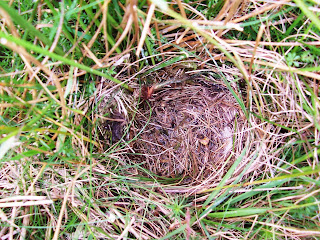This is my favourite season for many reasons. I just love the changing colours as the green from the plants chlorophyll production reduces and enables their pallete of other pigments to basically, show off! A bit like the chorus waiting in the wings, this is their turn to hit the stage and display, before finally disrobing in their grand finale or as others call it The Fall ..(not something you would see on a West End production!)
It really is a wonderful time of the year, it's harvest time in the hedgerows, time to stock up with free goodies in larder and freezer. It's so satisfying returning from walks with fruits, berries, nuts and mushrooms and to know that in winter ahead, one will be well fed.
Though this autumn in the west has not been as abundant, due mainly to much wetness!
I never cease to get pleasure from the dramatic way the landscape changes as autumn unfolds and the scents in the air alter. Sounds such as the dull thud of conkers as they hit the deep carpet of leaves beneath the horse chestnut trees. Watching the leaves on a light breeze, slowly, floating down like parachutes in a display team and the sycamore seeds that perform an aerial ballet, when they spin, twist and turn. It really is quite magical.

This year the hawthorn trees have excelled themselves. Everywhere I look, there are bright red beacons in the hedgerows with really plump, shining berries. Now ... if the old country folk lore be true, this means we are in for yet another harsh winter and those berries will seem like ruby beads against the satin white of the snow.
Everyone has been talking about the weather this year (even more so than us Brits are so renowned for!) but it has indeed been a strange year, with the weather almost splitting our islands in half, as the West & North got seemingly perpetual rainfall whilst the East & South suffered from drought. All of which caused different problems for all the farmers, growers and gardeners across the whole country. In the south eastern areas, many of the farmers (at great expense) were artificially irrigating their arid, arable crops, and yet for the fruit growers, apples ripened up to a month early, producing a glut of good fruit.
Here, sloes which are traditionally picked after the first frost, have grown as plump and juicy as damsons, in fact some folk I know have already started their sloe gin! ... "Hic!"
It has been a very jumbled up year in so very many ways. I was eating wild strawberries, raspberries and blackberries in September ... in the same handful ... weird!
But one of the saddest things for me, has been the severe lack of bees. Over the last few years I have definitely identified over ten species as I've explored the moorland and yet this year when out with the dog, I have often returned home without seeing a single bee. Even when the foxgloves and thistles were in full bloom, which would normally be so buzzingly busy, I rarely saw any bees at all. This indicates that (in our area at least) it is not only the honey bee that is in a state of crisis. There was also a severe lack of different butterflies and moths this year, one can only hope that this is an unusual blip, from which we will recover.
However, having mentioned thistles, I had a rare find in July, which as I write still has two very late flowers on it, whilst other thistles around it have long turned brown.
The Musk Thistle is a sturdy and rather grand plant. I've only found it in one place so far
It has the most beautiful, seemingly cobweb laced rosettes ...
Also known as the Drooping Thistle as the heavy heavy heads later bend with the weight,
these late flowers also attracted quite a few bees, such as this White Tailed nectar seeker ...
Just looking at that photograph, has reminded me of how few, clear blue, sunny skies we have had over the course of this year. But ... whatever the weather, there is always something which gives one pleasure in this small area of a much vaster planet.
In hindsight, we have been incredibly lucky, we have not been devastated by monsoons, tornado's or hurricanes. We are blessed with our temperamental yet temperate climate!
Motto for the day ... take pleasure from the smallest of moments!














































